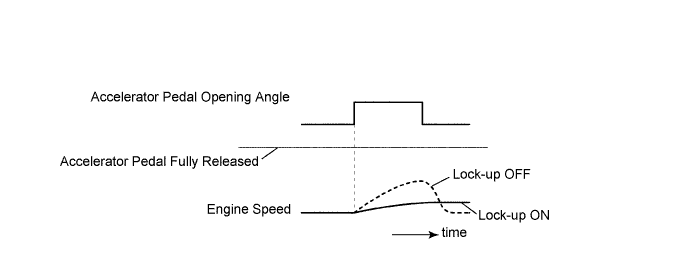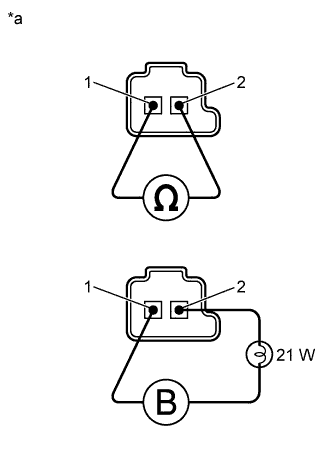TYPICAL MALFUNCTION THRESHOLDS
CHECK OTHER DTCS OUTPUT (IN ADDITION TO DTC P2757)
INSPECT SHIFT SOLENOID VALVE SLU
INSPECT TRANSMISSION VALVE BODY ASSEMBLY
INSPECT TORQUE CONVERTER CLUTCH ASSEMBLY
DTC P2757 Torque Converter Clutch Pressure Control Solenoid Performance (Shift Solenoid Valve SLU) |
DESCRIPTION
The ECM uses the signals from the throttle position sensor, turbine (input) speed sensor, vehicle speed sensor and crankshaft position sensor to monitor the engagement condition of the lock-up clutch.
Then the ECM compares the engagement condition of the lock-up clutch with the lock-up schedule in the ECM memory to detect mechanical problems of shift solenoid valve SLU, valve body and torque converter clutch.
| DTC No. | DTC Detection Condition | Trouble Area |
| P2757 | Lock-up does not occur when driving in lock-up range or lock-up remains ON in lock-up OFF range (2-trip detection logic). |
|
MONITOR DESCRIPTION
Torque converter lock-up is controlled by the ECM based on the speed sensor (NT), engine rpm (NE), engine load, engine coolant temperature, vehicle speed, transmission fluid temperature, and gear selection. The ECM determines the lock-up status of the torque converter by comparing the engine rpm (NE) to the input turbine rpm (NT). The ECM calculates the actual transmission gear by comparing input turbine rpm (NT) to output shaft speed. When conditions are appropriate, the ECM requests lock-up by applying the control voltage to shift solenoid valve SLU. When SLU is turned on, it applies pressure to the lock-up relay valve and locks the torque converter clutch.If the ECM detects no lock-up after lock-up has been requested or if it detects lock-up when it is not requested, the ECM interprets this as a fault in shift solenoid valve SLU or lock-up system performance. The ECM turns on the MIL and stores the DTC.
Example:
When either of the following is met, the system judges it as a malfunction.
- There is a difference in the rotations of the input side (engine speed) and output side (input turbine speed) of the torque converter when the ECM commands lock-up.
(Engine speed is at least 100 rpm greater than input turbine speed.) - There is no difference in the rotations of the input side (engine speed) and output side (input turbine speed) of the torque converter when the ECM commands lock-up off.
(The difference between engine speed and input turbine speed is less than 35 rpm.)
MONITOR STRATEGY
| Related DTCs | P2757: Shift solenoid valve SLU/OFF malfunction Shift solenoid valve SLU/ON malfunction |
| Required sensors/Components | Shift solenoid valve SLU, Speed sensor (NT), Crankshaft position sensor (NE) |
| Frequency of operation | Continuous |
| Duration | OFF malfunction: 3.5 seconds ON malfunction: 1.8 seconds |
| MIL operation | 2 driving cycles |
| Sequence of operation | None |
TYPICAL ENABLING CONDITIONS
The following conditions are common to OFF malfunction and ON malfunction.| Time after shifting N to D | 4.5 seconds or more |
| ECT (Engine Coolant Temperature) | 60°C (140°F) or more |
| Transmission shift position | D |
| ECM selected gear | 3rd or 4th |
| Vehicle speed | 25 km/h (15.5 mph) or more |
| Shift Solenoid "A" (S1) circuit | No circuit malfunction (P0973, P0974) |
| Shift Solenoid "B" (S2) circuit | No circuit malfunction (P0976, P0977) |
| Torque Converter Clutch Pressure Control Solenoid (SLU) circuit | No circuit malfunction (P2759) |
| ECT sensor circuit | No circuit malfunction (P0115, P0117, P0118) |
| Turbine Speed Sensor circuit | No circuit malfunction (P0717) |
| Vehicle Speed Sensor "A" circuit | No circuit malfunction (P0500) |
| Electronic Throttle Control System | No circuit malfunction (P0120, P0121, P0122, P0123, P0220, P0222, P0223, P0604, P0606, P0607*1, P060A, P060D, P060E, P0657, P1607, P2102, P2103, P2111, P2112, P2118, P2119, P2135) |
- *1: for Mexico models
| ECM lock-up command | ON |
| Duration time from lock-up on command | 3 seconds or more |
| Actual gear | 3rd or 4th |
| ECM lock-up command | OFF |
| Throttle valve opening angle | 8% or more |
| Vehicle speed | Less than 60 km/h (37.3 mph) |
| Actual gear | 3rd |
| Calculated load value | 22% or more |
TYPICAL MALFUNCTION THRESHOLDS
| Engine speed - Input (turbine) speed (NE - NT) | 100 rpm or more |
- 2 detections are necessary per driving cycle.
1st detection: Temporary flag ON
2nd detection: Pending fault code ON
Vehicle speed must be under 10 km/h (6.2 mph) once before 2nd detection.
| Difference between engine speed and Input (turbine) speed | Less than 35 rpm |
INSPECTION PROCEDURE
- NOTICE:
- Perform the universal trip to clear permanent DTCs (YARIS_NCP93 RM000000W770MGX.html).
| ACTIVE TEST |
- HINT:
- Using the Techstream to perform Active Tests allows relays, VSVs, actuators and other items to be operated without removing any parts. This non-intrusive functional inspection can be very useful because intermittent operation may be discovered before parts or wiring is disturbed. Performing Active Tests early in troubleshooting is one way to save diagnostic time. Data List information can be displayed while performing Active Tests.
- It is possible to display the Data List during the Active Test.
Warm up the engine.
Turn the ignition switch off.
Connect the Techstream to the DLC3.
Turn the ignition switch to ON.
Turn the Techstream on.
Enter the following menus: Powertrain / Engine and ECT / Active Test.
According to the display on the Techstream, perform the Active Test.
Tester Display Test Part Control Range Diagnostic Note Activate the Lock Up [Test Details]
Control shift solenoid SLU to set automatic transaxle to lock-up condition.ON/OFF Possible to check Lock-up operation.
[Vehicle Condition]
Vehicle Speed: 60 km/h (36 mph) or more, and 4th gear- HINT:
- This test can be conducted when the vehicle speed is 60 km/h (36 mph) or less.
- This test can be conducted in 4th gear.
Lightly depress the accelerator pedal and check that the engine speed does not change abruptly.

- HINT:
- When changing the accelerator pedal opening angle while driving, if the engine speed does not change, lock-up is on.
- Slowly, but not fully, release the accelerator pedal in order to decelerate. (Fully releasing the pedal will close the throttle valve and lock-up may be turned off.)
| 1.CHECK OTHER DTCS OUTPUT (IN ADDITION TO DTC P2757) |
Connect the Techstream to the DLC3.
Turn the ignition switch to ON.
Turn the Techstream on.
Enter the following menus: Powertrain / Engine and ECT / Trouble Codes.
Read the DTCs using the Techstream.
Result Result Proceed to P2757 is output A P2757 and other DTCs are output B - HINT:
- If any other DTCs besides P2757 are output, perform troubleshooting for those DTCs first.
|
| ||||
| A | |
| 2.INSPECT SHIFT SOLENOID VALVE SLU |
 |
Remove shift solenoid valve SLU.
Measure the resistance according to the value(s) in the table below.
- Standard Resistance:
Tester Connection Condition Specified Condition 1 - 2 20°C (68°F) 5.0 to 5.6 Ω
Connect the positive (+) lead with a 21 W bulb to terminal 2 and the negative (-) lead to terminal 1 of the solenoid valve connector, then check the movement of the valve.
- OK:
- The solenoid makes operating sounds.
Text in Illustration *a Component without harness connected
(Shift Solenoid Valve SLU)
|
| ||||
| OK | |
| 3.INSPECT TRANSMISSION VALVE BODY ASSEMBLY |
- OK:
- There are no foreign objects on any valves and they operate smoothly.
|
| ||||
| OK | |
| 4.INSPECT TORQUE CONVERTER CLUTCH ASSEMBLY |
- OK:
- The torque converter clutch operates normally.
|
| ||||
| OK | ||
| ||